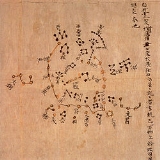
Chinese astronomy
Overview
Star names later categorized in the twenty-eight mansions
Twenty-eight mansions
The Twenty-eight Mansions , ', ' or ' are part of the Chinese constellations system. They can be considered as the equivalent to the zodiacal constellations in the Western astronomy, though the Twenty-eight Mansions reflect the movement of the Moon in a lunar month rather than the Sun in a solar year...
have been found on oracle bones unearthed at Anyang
Anyang
Anyang is a prefecture-level city in Henan province, People's Republic of China. The northernmost city in Henan, Anyang borders Puyang to the east, Hebi and Xinxiang to the south, and the provinces of Shanxi and Hebei to its west and north respectively....
, dating back to the middle Shang Dynasty
Shang Dynasty
The Shang Dynasty or Yin Dynasty was, according to traditional sources, the second Chinese dynasty, after the Xia. They ruled in the northeastern regions of the area known as "China proper" in the Yellow River valley...
(Chinese Bronze Age), and the mansion (xiù:宿) system's nucleus seems to have taken shape by the time of the ruler Wu Ding
Wu Ding
Wu Ding was a Shang Dynasty King of China.His is the first historically verifiable name in the history of Chinese dynasties...
(1339-1281 BC).
Detailed records of astronomical observations began during the Warring States period
Warring States Period
The Warring States Period , also known as the Era of Warring States, or the Warring Kingdoms period, covers the Iron Age period from about 475 BC to the reunification of China under the Qin Dynasty in 221 BC...
(4th century BC) and flourished from the Han period onwards.
Discussions

